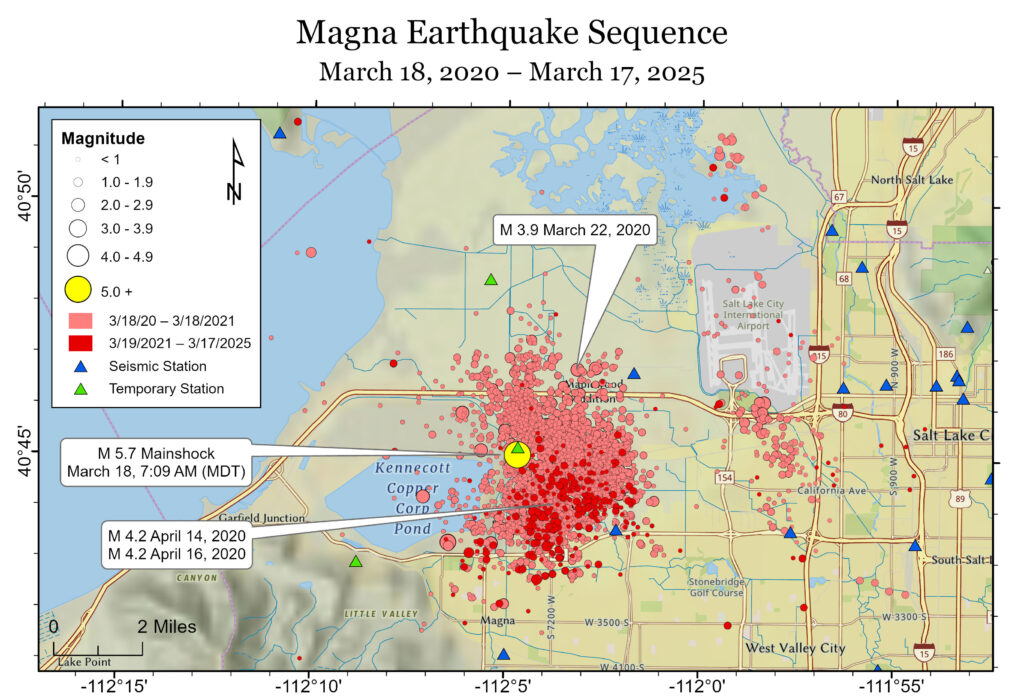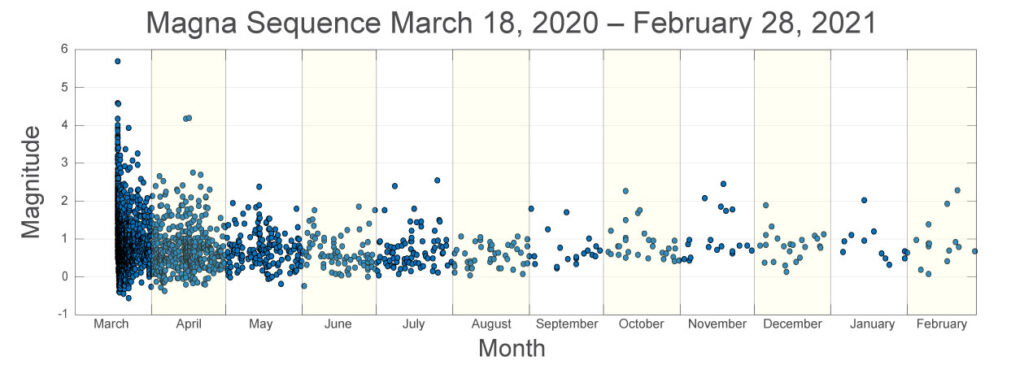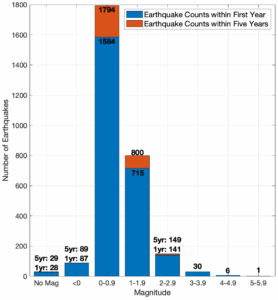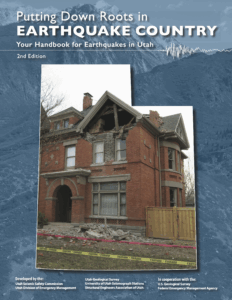Updated March 17, 2025
In the five years following the 2020 M5.7 Magna earthquake, UUSS has located over 2,800 aftershocks within 15 km of the mainshock epicenter, with magnitudes ranging -0.6 to 4.6. About 90% of the aftershocks occurred within the first year (March 18, 2020-March 18, 2021). Even though it has been five years, the aftershock sequence is ongoing. In the past 12 months, UUSS has recorded 49 earthquakes within 15 km (9 mi) of the mainshock, with magnitudes ranging from -0.2 to 2.5. This number of earthquakes is significantly above the background seismicity rate of <10 earthquakes a year in the same area. Aftershocks decrease in both number and magnitude as time passes, and even though the sequence is ongoing we don’t necessarily anticipate any more of the larger aftershocks that were felt throughout the Salt Lake Valley in the days and weeks following the 2020 mainshock.


UUSS Publications

USGS Event Page for the Mainshock
Moment Tensor Information
- UUSS Moment Tensor webpage
- Downloadable Moment Tensor Catalog (Excel File)
- UUSS Moment Tensor Solutions for the 2020 Magna Sequence
More Information
- UUSS Magna Sequence FAQ
- Earthquakes.utah.gov
- Dr. Kris Pankow’s outreach talk “Earthquakes Don’t Stop for Pandemics” presented to the Intermountain Center for Disaster Preparedness (ICDP) on August 26. 2020.
- View our News and Press Releases related to the Magna sequence
Scientific papers related to the 2020 Mw 5.7 Magna, UT earthquake
- Pankow, K. L., J. Rusho, J. C. Pechmann, J. M. Hale, K. Whidden, R. Sumsion, J. Holt, M. Mesimeri, D. Wells, and K. D. Koper (2021). Responding to the Magna, Utah, earthquake sequence during the COVID-19 pandemic shutdown, Seism. Res. Lett., 92(2A), 6-16, https://doi.org/10.1785/0220200265.
- Mesimeri, M., H. Zhang, and K. L. Pankow (2020). Backprojection imaging of the 2020 Mw 5.5 Magna, Utah, earthquake using a local dense strong-motion network, Seism. Res. Lett., 92(2A), 640-646, https://doi.org/10.1785/0220200326.
- Kleber, E. J., A. P. McKean, A. I. Hiscock, M. D. Hylland, C. L. Hardwick, G. N. McDonald, Z. W. Anderson, S. D. Bowman, G. C. Willis, and B. A. Erickson (2020). Geologic Setting, Ground Effects, and Proposed Structural Model for the 18 March 2020 Mw 5.7 Magna, Utah, Earthquake, Seismol. Res. Lett., 92(2A), 710-724, https://doi.org/10.1785/0220200331.
- Holt, J., K. M. Whidden, K. D. Koper, K. L. Pankow, K. Mayeda, J. C. Pechmann, B. Edwards, R. Gok, and W.R. Walter (2021). Towards robust and routine determination of Mw for small earthquakes: Application to the 2020 Mw 5.7 Magna, Utah, seismic sequence, Seism. Res. Lett.,92(2A), 725-740, https://doi.org/10.1785/0220200320.
- Pollitz, F. F., C. W. Wicks, and J. L. Svarc (2021). Coseismic Fault Slip and Afterslip Associated with the 18 March 2020 M 5.7 Magna, Utah, Earthquake, Seismol. Res. Lett., 92(2A), 741-754, https://doi.org/10.1785/0220200312.
- Wong, I., Q. Wu, and J. C. Pechmann (2021). The 18 March 2020 M 5.7 Magna, Utah, Earthquake: Strong-Motion Data and Implications for Seismic Hazard in the Salt Lake Valley, Seismol. Res. Lett., 773-786, https://doi.org/10.1785/0220200323.
- Baker, B., M. Holt, K. L. Pankow, K. D. Koper, and J. Farrell (2021). Monitoring the 2020 Magna, Utah earthquake sequence with Nodal seismometers and machine learning, Seism. Res. Lett., 92(2A), 787-801, https://doi.org/10.1785/0220200316.
- Pang, G., K. D. Koper, M. Mesimeri, K.L. Pankow, B. Baker, J. Farrell, J. Holt, P. Roberson, R. Burlacu, J. C. Pechmann, K. Whidden, M. M. Holt, A. Allam, and C. DuRoss (2020). Seismic Analysis of the 2020 Magna, Utah, Earthquake Sequence: Evidence for a Listric Wasatch Fault, Geophys. Res. Lett., 47 (18), e2020GL089798. https://doi.org/10.1029/2020GL089798.
- Hiscock, A. I., E. J. Kleber, A. P. McKean, B. A. Erickson, G. N. McDonald, R. E. Giraud, J. J. Castleton, and S. D. Bowman (2023). The March 2020, Mw 5.7 Magna, Utah, earthquake - documentation of geologic effects and summary of new research, Geology of the Intermountain West, 10, https://doi.org/10.31711/giw.v10.pp113-129.
- Wells, D., A. Lomax, B. Baker, J. Bartley, and K. Pankow (2024). Wasatch Fault Structure from Machine Learning Arrival Times and High-Precision Earthquake Locations, Bull. Seis. Soc. Am., 114(4), https://doi.org/10.1785/0120230247.
Frequently Asked Questions about the 2020 Magna Earthquake Sequence
How many earthquakes have we had in the area?
The University of Utah Seismograph Stations (UUSS) has located 2,590 earthquakes that occurred in the Magna, Utah, area from March 18 through February 28, 2021(Figure 1). The largest of these earthquakes was the magnitude (M) 5.7 mainshock that occurred at 7:09 am MDT on Wednesday, March 18, 2020. The remaining 2,589 earthquakes are aftershocks. The largest aftershocks were two M 4.6 events that occurred at 8:02 am and 1:12 pm on Wednesday, March 18, 2020. A M 4.2 aftershocks occurred on April 14 and 17th which were widely felt along the Wastach Front. There have been 36 aftershocks of M 3 and larger. We continue to locate new earthquakes as they occur.
What is a Foreshock, Mainshock, or Aftershock?
Mainshocks, foreshocks, and aftershocks are all earthquakes. The mainshock is the largest magnitude earthquake in an earthquake sequence. It may be the first event in the sequence or occur later. The earthquakes in the sequence that occur before the mainshock are called foreshocks and the ones that occur after are called aftershocks. Sometimes an earthquake that is initially called the mainshock is reclassified as a foreshock because a larger earthquake follows it. An earthquake sequence is a group of events that occur close together in time in the same area.
What is the difference between UUSS and USGS?
The University of Utah Seismograph Stations (UUSS) and the U.S. Geological Survey (USGS) are partner agencies. All seismic data from the Utah region are collected and initially processed by UUSS. The resulting earthquake locations, magnitudes, and ShakeMaps are submitted to the USGS, which serves the information on a USGS website. USGS personnel often provide additional information on their website related to how the earthquake ruptured, how widely the earthquake was felt, the potential economic and life impacts, and the chances of aftershocks and landslides. As members of the Advanced National Seismic System (ANSS), UUSS and USGS work together to provide the most accurate and complete information about earthquakes in the Utah region.
We had a 5.7 earthquake, what are the percentages of having a larger earthquake soon?
Most likely, the 5.7 earthquake will end up being the biggest earthquake in this sequence and so it will be called the mainshock. There is a small chance, roughly one-in-twenty (5%), that a larger earthquake will occur in the next 5-6 days after the mainshock. In that case, the 5.7 earthquake would be redesignated as a foreshock, and the new, larger earthquake will be called the mainshock. A “larger” earthquake means any earthquake bigger than the one that just occurred, even if it is only 0.1 magnitude units bigger. The probability of an earthquake being a foreshock to an earthquake that is one or two magnitude units larger is much smaller than one-in-twenty.
How long did the mainshock last?
How long you felt the shaking would depends on where you were. For the
Magna Earthquake, if you were downtown, the strongest shaking lasted around 4-6 sec. However, the shaking was strong enough to be felt for about 20 sec.
Will this delay or trigger “the big one?”
No, small earthquakes do not relieve enough stress in the earth to reduce the likelihood of a large earthquake. We are still at risk of a magnitude 7-7.5 earthquake (the “Big One”) occurring somewhere along the Wasatch fault. The risk is similar to what it was before the Magna sequence.
How will I be notified of the next earthquake?
Anyone can sign up for Earthquake Notification Service (ENS) and receive emails or text messages about earthquakes as the locations are published. You may set up your own geographic area and magnitude threshold. All UUSS earthquake locations are sent out via the ENS system. Sign up here.
Will the ground open up or Fracture from the 5.7 earthquake?
It is unlikely for the fault rupture from the 5.7 earthquake to reach all the way to the surface and create what we call a scarp. It is possible that shaking from the 5.7 created liquefaction features at the surface near the epicenter.
Why can’t Utah get a M9.0 Earthquake?
The bigger an earthquake is, the more space on a fault it takes up. The faults in Utah simply are not big enough to accommodate an M9 earthquake.
How does the earthquake depth affect the shaking and how do you measure the depth?
The shallower the depth of an earthquake, the stronger the shaking will be near the epicenter; however, the strength of shaking will fall off more rapidly away from the epicenter. It is the same idea as aiming a flashlight at a wall and walking toward the wall. The closer you get to the wall the more intense the light becomes, but it takes up a smaller area. Earthquake depth is measured from the arrival times of seismic waves, similar to how the epicenter is determined.
Are earthquakes more common now?
No. There is no evidence for change in the overall rate that earthquakes occur.
What can I do to be prepared?
An excellent source of information on earthquake preparedness is the publication "Putting Down Routes in Earthquake Country", available in English and Español.
